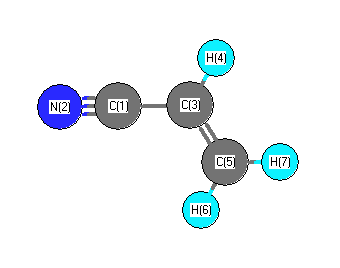.
| squib |
reference |
DOI |
| 1954Wil/Gol:516 |
Wilcox, W.S.; Goldstien, J.H. "The Microwave Spectrum of Vinyl Cyanide." Journal of Chemical Physics. 22, 516-518 (1954) |
10.1063/1.1740098 |
| 1976Hellwege(II/7) |
Hellwege, KH and AM Hellwege (ed.). Landolt-Bornstein: Group II: Atomic and Molecular Physics Volume 7: Structure Data of Free Polyatomic Molecules. Springer-Verlag. Berlin. 1976. |
|
| 1995Mot/Mes:80 |
Motte-Tollet, Messina, and Hubin-Franskin. Electronic and Vibrational Excitation of Acrylonitrile By Low and Intermediate Energy Electrons. J. Chem. Phys. Vol.103, #1, pgs. 80-89. |
10.1063/1.469625 |
| 2011Kra/Zbi:83-87 |
A Krasnicki, Z Kisiel "Electric dipole moments of acrylonitrile and of propionitrile measured in supersonic expansion" J. Mol. Spect. 270, 83-87, 2011 |
10.1016/j.jms.2011.08.006 |
| TRC |
Frenkel, M; Marsh, K.N.; Wilhoit, R.C.; Kabo, G.J.; Roganov, G.N.,Thermodynamics of Organic Compounds in the Gas State,Thermodynamics Research Center, College Station, TX, 1994 |
|
| webbook |
NIST Chemistry Webbook (http://webbook.nist.gov/chemistry) |
10.18434/T4D303 |










